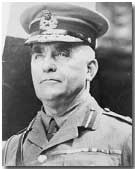Who's Who - Sam Hughes
 Sam Hughes (1853-1921)
served as Canada's Minister of Militia and Defence from 1911 until his
dismissal at the hands of Prime Minister
Sir Robert Borden in
1916.
Sam Hughes (1853-1921)
served as Canada's Minister of Militia and Defence from 1911 until his
dismissal at the hands of Prime Minister
Sir Robert Borden in
1916.
Hughes' career began with the Canadian armed forces with whom he served during the South African War of 1899-1902 where he earned a reputation - among British commanders if rather less so among his own colleagues - of being a first rate leader of irregular forces.
In October 1911 Hughes was appointed to a political post as Minister of Militia and Defence in spite of having already established a reputation for himself as something of a religious bigot: he was especially unpopular with many French Canadians. A committed nationalist-imperialist determined to establish a more prominent role for Canadian forces within the British Empire he moved quickly to encourage military recruitment via the cadet corps.
At an early stage Hughes promoted the principle of local supply of clothing, arms and munitions. In particular he sponsored the development of the long and heavy Ross rifle which performed particularly well as a target rifle. Over time it was Hughes' adamant support of the Ross rifle which brought about his eventual dismissal.
The outbreak of war in August 1914 prompted the highly energetic Hughes to co-ordinate the recruitment of Canadian troops for despatch to the battlefields of the Western Front. He boosted Canada's pre-war regular force of 3,000 with militia troops in addition to the fruits of widespread voluntary recruitment.
Hughes oversaw the construction of a training facility, Camp Valcartier, in under three weeks, followed later by additional camps. Within a matter of weeks the first Canadian forces were ready to sail for Europe from Quebec City. The departing troops were given a pep talk by Hughes prior to their departure.
Although Hughes was given due credit for overseeing the prompt recruitment, training and despatch of forces for active duty, he nevertheless came under fire for his particular insistence upon local sourcing of war material. In addition to ignoring evidence that his beloved Ross rifle was prone to locking under rapid-fire trench conditions he was accused of supplying his force with leaky boots and poorly performing trench equipment. Munitions production was deemed substandard and there were widespread accusations of corruption surrounding its production.
With criticism of Hughes mounting from within the government - Hughes continued to refuse to concede difficulties in the use of the Ross rifle in battlefield conditions in spite of professional advice to the contrary - the Prime Minister, Sir Robert Borden, determined to limit Hughes' role.
When it emerged that in August 1916 that Hughes had established a sub-militia council while in London without prior Cabinet authorisation Borden reminded him that decisions affecting the Canadian Expeditionary Force were overseen at Cabinet level only. To this end Borden proposed the establishment of the Ministry of Overseas Forces towards the close of September 1916. It came into formal being on 27 October 1916 and was overseen by Sir George Halsey Perley.
Hughes, accustomed to something of a roving and wide-ranging brief, reacted with fury and strove to overturn Borden's decision. Finding his campaign in vain he wrote Borden an impertinent letter in which he took the Prime Minister to task. Borden, increasingly finding Hughes a political and military liability, dismissed him from his ministerial post in November 1916.
A backbencher for the remainder of his life Hughes died in 1921.
A 'Woolly Bear' comprised a German shrapnel shell, which burst with a cloud-like explosion.
- Did you know?
